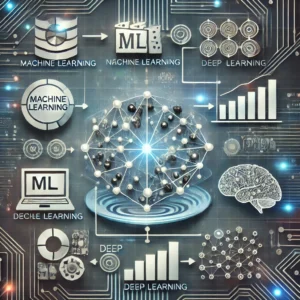Machine Learning and Deep Learning
AI evolved over time, and researchers developed different methods to make machines learn. Machine Learning (ML) is one of these methods, where machines learn from data instead of following strict rules. Later, Deep Learning emerged, using networks of algorithms inspired by the human brain to learn and make decisions. This is the foundation of many AI technologies today.

Introduction to Machine Learning (ML):
As AI research progressed, scientists realized that creating fixed rules for every possible scenario a machine might encounter was impractical. Instead, they developed Machine Learning (ML), a method that allows machines to learn from data and improve their performance over time without being explicitly programmed for every task.
What is Machine Learning?
Machine Learning is a subset of AI that enables systems to learn from data, identify patterns, and make decisions with minimal human intervention. Instead of following predefined rules, an ML algorithm uses data to build models that can predict outcomes or identify trends. This approach allows machines to adapt to new situations by learning from previous experiences.
Types of Machine Learning:
- Supervised Learning:
- The algorithm is trained on labeled data, meaning the input data is paired with the correct output.
- Example: Spam detection in email, where the algorithm learns to classify emails as spam or not spam based on examples.
- Unsupervised Learning:
- The algorithm is given data without labels and must find patterns or groupings on its own.
- Example: Customer segmentation in marketing, where the algorithm identifies different customer groups based on purchasing behavior.
- Reinforcement Learning:
- The algorithm learns by interacting with its environment, receiving rewards or penalties for actions taken.
- Example: Training a robot to navigate a maze, where it learns to reach the goal by trial and error.
The Emergence of Deep Learning:
While Machine Learning made significant strides, certain tasks, such as image and speech recognition, remained challenging. This led to the development of Deep Learning, a more advanced form of Machine Learning that mimics the workings of the human brain.
What is Deep Learning?
Deep Learning involves the use of neural networks with many layers—hence the term “deep.” These layers process information in a way that allows the system to recognize complex patterns in data, such as identifying objects in an image or understanding spoken language.
How Deep Learning Works:
- Neural Networks:
- Inspired by the human brain, neural networks consist of layers of interconnected nodes (neurons) that process and transmit information.
- Each layer of the network analyzes the input data, extracting features and passing them to the next layer.
- The network “learns” by adjusting the connections (weights) between nodes based on the errors in its predictions, a process known as backpropagation.
- Applications of Deep Learning:
- Image Recognition: Systems like Google Photos use deep learning to recognize and categorize images.
- Natural Language Processing (NLP): Virtual assistants like Siri and Alexa understand and respond to spoken language using deep learning.
- Autonomous Vehicles: Self-driving cars rely on deep learning to interpret visual data from cameras and sensors.
Conclusion: Machine Learning and Deep Learning are the driving forces behind many of today’s AI technologies. By enabling machines to learn from data, these methods allow AI to perform tasks that were once thought to be the exclusive domain of humans, such as recognizing speech, identifying objects, and making decisions.
